Page 308 of 480
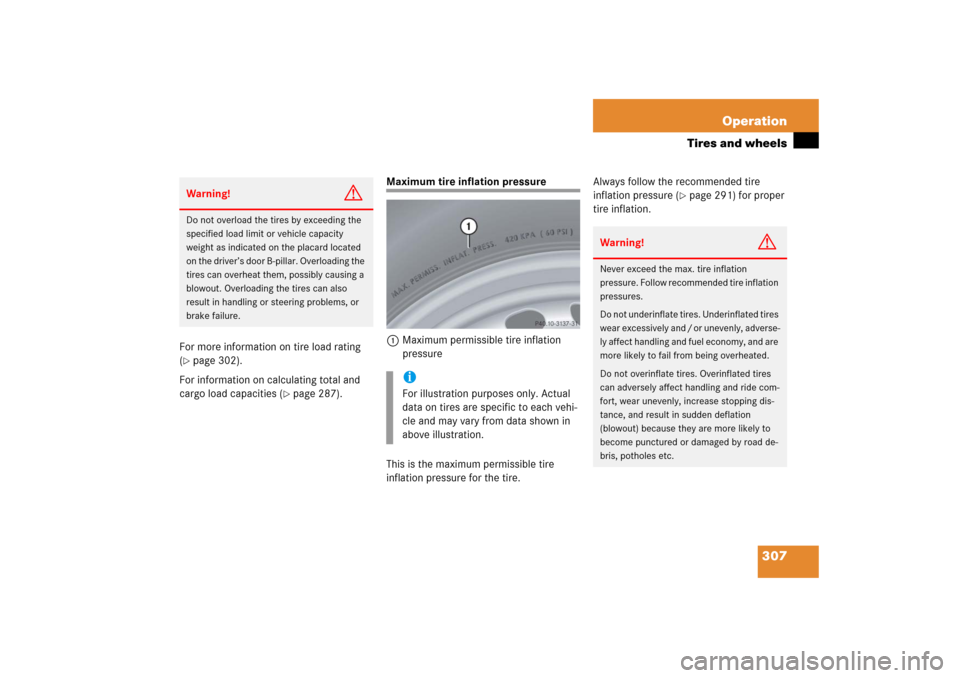
307 Operation
Tires and wheels
For more information on tire load rating
(�page 302).
For information on calculating total and
cargo load capacities (
�page 287).
Maximum tire inflation pressure
1Maximum permissible tire inflation
pressure
This is the maximum permissible tire
inflation pressure for the tire.Always follow the recommended tire
inflation pressure (
�page 291) for proper
tire inflation.
Warning!
G
Do not overload the tires by exceeding the
specified load limit or vehicle capacity
weight as indicated on the placard located
on the driver’s door B-pillar. Overloading the
tires can overheat them, possibly causing a
blowout. Overloading the tires can also
result in handling or steering problems, or
brake failure.
iFor illustration purposes only. Actual
data on tires are specific to each vehi-
cle and may vary from data shown in
above illustration.
Warning!
G
Never exceed the max. tire inflation
pressure. Follow recommended tire inflation
pressures.
Do not underinflate tires. Underinflated tires
wear excessively and / or unevenly, adverse-
ly affect handling and fuel economy, and are
more likely to fail from being overheated.
Do not overinflate tires. Overinflated tires
can adversely affect handling and ride com-
fort, wear unevenly, increase stopping dis-
tance, and result in sudden deflation
(blowout) because they are more likely to
become punctured or damaged by road de-
bris, potholes etc.
Page 311 of 480
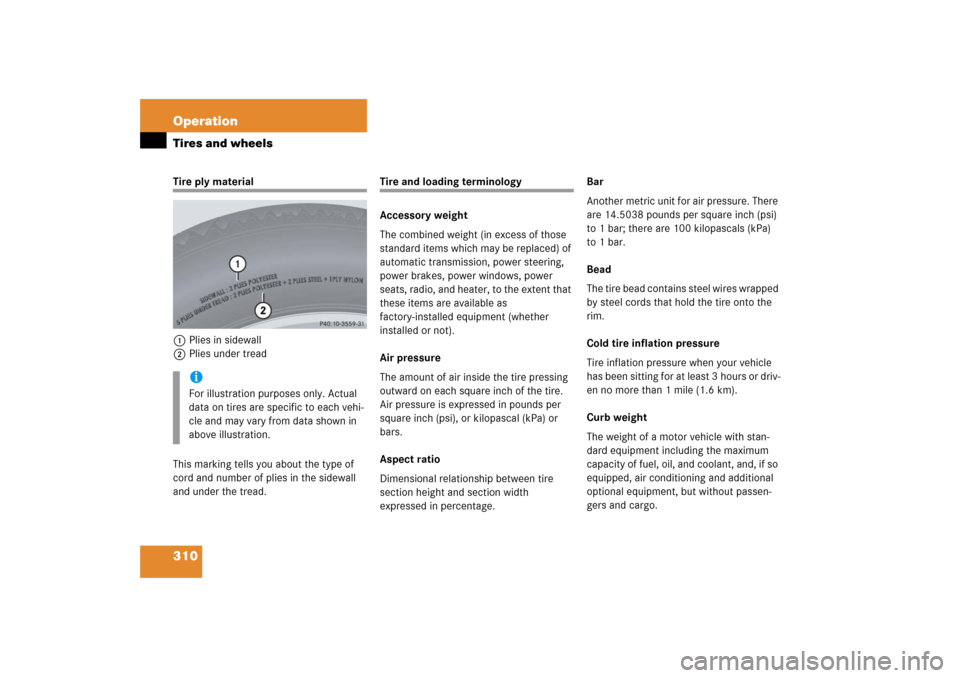
310 OperationTires and wheelsTire ply material
1Plies in sidewall
2Plies under tread
This marking tells you about the type of
cord and number of plies in the sidewall
and under the tread.
Tire and loading terminology
Accessory weight
The combined weight (in excess of those
standard items which may be replaced) of
automatic transmission, power steering,
power brakes, power windows, power
seats, radio, and heater, to the extent that
these items are available as
factory-installed equipment (whether
installed or not).
Air pressure
The amount of air inside the tire pressing
outward on each square inch of the tire.
Air pressure is expressed in pounds per
square inch (psi), or kilopascal (kPa) or
bars.
Aspect ratio
Dimensional relationship between tire
section height and section width
expressed in percentage.Bar
Another metric unit for air pressure. There
are 14.5038 pounds per square inch (psi)
to 1 bar; there are 100 kilopascals (kPa)
to 1 bar.
Bead
The tire bead contains steel wires wrapped
by steel cords that hold the tire onto the
rim.
Cold tire inflation pressure
Tire inflation pressure when your vehicle
has been sitting for at least 3 hours or driv-
en no more than 1 mile (1.6 km).
Curb weight
The weight of a motor vehicle with stan-
dard equipment including the maximum
capacity of fuel, oil, and coolant, and, if so
equipped, air conditioning and additional
optional equipment, but without passen-
gers and cargo.
iFor illustration purposes only. Actual
data on tires are specific to each vehi-
cle and may vary from data shown in
above illustration.
Page 320 of 480

319 Operation
Maintenance
1Reset button�
Press reset button1 on the instru-
ment cluster.
The maintenance service indicator
message is cleared and the standard
display appears in the multifunction
display (
�page 140).Maintenance service term exceeded
If you have exceeded the suggested main-
tenance service term, you will see the fol-
lowing message in the right multifunction
display:
Service A exceeded by XXXX miles (km)
Service A exceeded by XXX daysIn addition, a signal sounds when the mes-
sage appears.
Any authorized Mercedes-Benz Center will
reset the maintenance service indicator
following a completed maintenance ser-
vice.Calling up the maintenance service
indicator display�
Switch on the ignition (
�page 36).
The standard display of the control sys-
tem appears (
�page 135).
�
Press button è or ÿ on the mul-
tifunction steering wheel repeatedly
until the standard display appears in
the multifunction display (
�page 140).
�
Press button k or j on the
multifunction steering wheel until the
maintenance service indicator mes-
sage with the maintenance service
symbol 9 or
½
appears in the
left multifunction display and the main-
tenance service deadline appears in
the right multifunction display.
��
Page 331 of 480

330 OperationVehicle careSteering wheel and gear selector lever�
Wipe with a damp cloth and dry thor-
oughly or clean with Mercedes-Benz
approved Leather Care.
Carpets
�
Use Mercedes-Benz approved Carpet
and Fabric Care for cleaning the car-
pets.
Headliner
�
Use a soft bristle brush or a dry-sham-
poo cleaner in case of excessive dirt.
Seat belts
�
Only use clear, lukewarm water and
soap.Upholstery
Using aftermarket seat covers or wearing
clothing that have the tendency to give off
coloring (e.g. when wet, etc.) may cause
the upholstery to become permanently dis-
colored. By lining the seats with a proper
intermediate cover, contact-discoloration
will be prevented.Leather upholstery
�
Wipe leather upholstery with a damp
cloth and dry thoroughly or clean with
Mercedes-Benz approved Leather
Care.
Exercise particular care when cleaning per-
forated leather as its underside should not
become wet.
Wood trims
�
Dampen cloth using water and use
damp cloth to clean wood trims in your
vehicle.
Do not use solvents like tar remover or
wheel cleaner nor polishes or waxes as
these may be abrasive.
!The webbing must not be treated with
chemical cleaning agents. Do not dry
the webbing at temperatures above
176°F (80°C) or in direct sunlight.
Warning!
G
Do not bleach or dye seat belts as this may
severely weaken them. In a crash they may
not be able to provide adequate protection.
Page 334 of 480
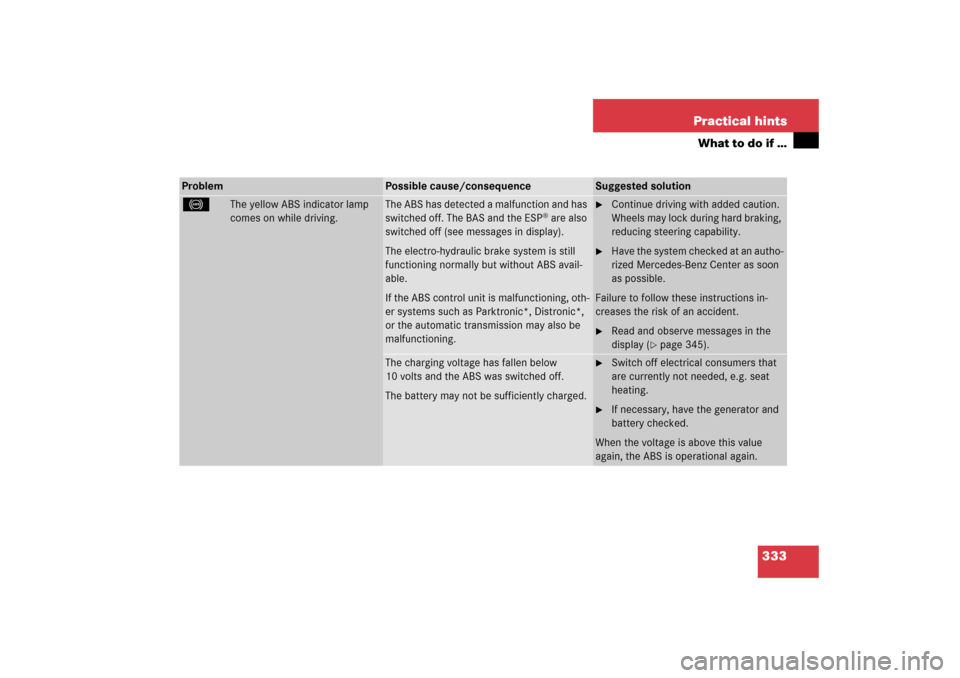
333 Practical hints
What to do if …
Problem
Possible cause/consequence
Suggested solution
-
The yellow ABS indicator lamp
comes on while driving.
The ABS has detected a malfunction and has
switched off. The BAS and the ESP
® are also
switched off (see messages in display).
The electro-hydraulic brake system is still
functioning normally but without ABS avail-
able.
If the ABS control unit is malfunctioning, oth-
er systems such as Parktronic*, Distronic*,
or the automatic transmission may also be
malfunctioning.
�
Continue driving with added caution.
Wheels may lock during hard braking,
reducing steering capability.
�
Have the system checked at an autho-
rized Mercedes-Benz Center as soon
as possible.
Failure to follow these instructions in-
creases the risk of an accident.
�
Read and observe messages in the
display (
�page 345).
The charging voltage has fallen below
10 volts and the ABS was switched off.
The battery may not be sufficiently charged.
�
Switch off electrical consumers that
are currently not needed, e.g. seat
heating.
�
If necessary, have the generator and
battery checked.
When the voltage is above this value
again, the ABS is operational again.
Page 343 of 480
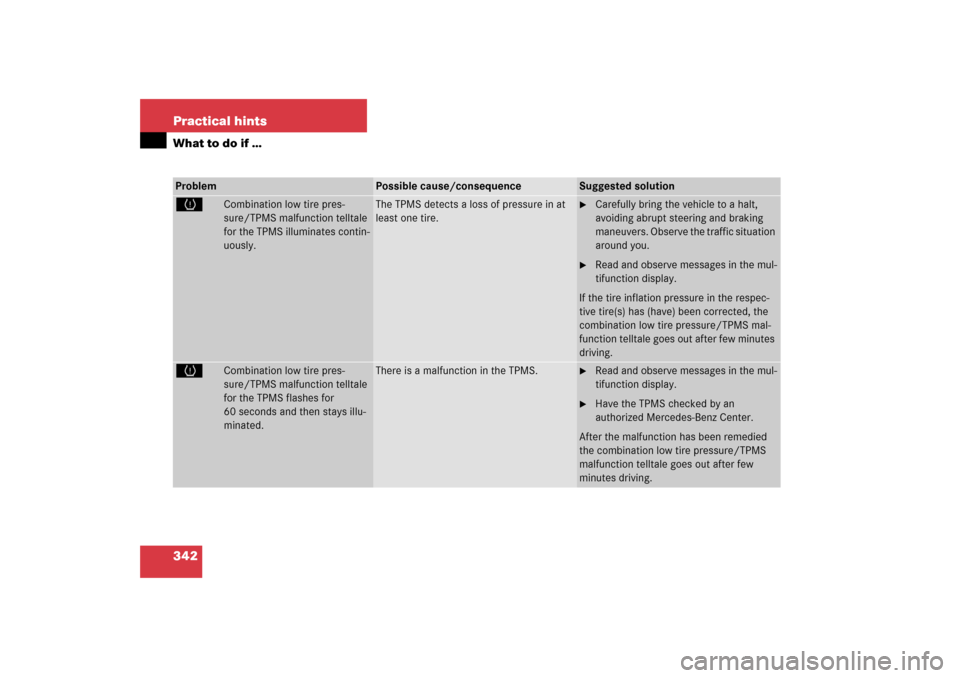
342 Practical hintsWhat to do if …Problem
Possible cause/consequence
Suggested solution
H
Combination low tire pres-
sure/TPMS malfunction telltale
for the TPMS illuminates contin-
uously.
The TPMS detects a loss of pressure in at
least one tire.
�
Carefully bring the vehicle to a halt,
avoiding abrupt steering and braking
maneuvers. Observe the traffic situation
around you.
�
Read and observe messages in the mul-
tifunction display.
If the tire inflation pressure in the respec-
tive tire(s) has (have) been corrected, the
combination low tire pressure/TPMS mal-
function telltale goes out after few minutes
driving.
H
Combination low tire pres-
sure/TPMS malfunction telltale
for the TPMS flashes for
60 seconds and then stays illu-
minated.
There is a malfunction in the TPMS.
�
Read and observe messages in the mul-
tifunction display.
�
Have the TPMS checked by an
authorized Mercedes-Benz Center.
After the malfunction has been remedied
the combination low tire pressure/TPMS
malfunction telltale goes out after few
minutes driving.
Page 346 of 480
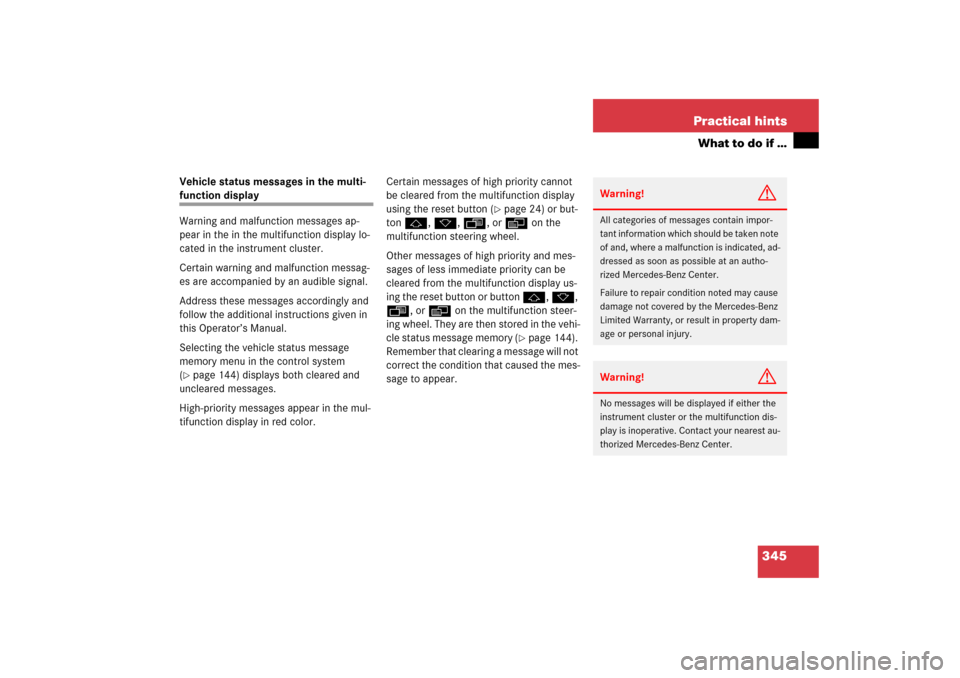
345 Practical hints
What to do if …
Vehicle status messages in the multi-function display
Warning and malfunction messages ap-
pear in the in the multifunction display lo-
cated in the instrument cluster.
Certain warning and malfunction messag-
es are accompanied by an audible signal.
Address these messages accordingly and
follow the additional instructions given in
this Operator’s Manual.
Selecting the vehicle status message
memory menu in the control system
(�page 144) displays both cleared and
uncleared messages.
High-priority messages appear in the mul-
tifunction display in red color.Certain messages of high priority cannot
be cleared from the multifunction display
using the reset button (
�page 24) or but-
ton j, k, ÿ, or è on the
multifunction steering wheel.
Other messages of high priority and mes-
sages of less immediate priority can be
cleared from the multifunction display us-
ing the reset button or button j, k,
ÿ, or è on the multifunction steer-
ing wheel. They are then stored in the vehi-
cle status message memory (
�page 144).
Remember that clearing a message will not
correct the condition that caused the mes-
sage to appear.
Warning!
G
All categories of messages contain impor-
tant information which should be taken note
of and, where a malfunction is indicated, ad-
dressed as soon as possible at an autho-
rized Mercedes-Benz Center.
Failure to repair condition noted may cause
damage not covered by the Mercedes-Benz
Limited Warranty, or result in property dam-
age or personal injury.Warning!
G
No messages will be displayed if either the
instrument cluster or the multifunction dis-
play is inoperative. Contact your nearest au-
thorized Mercedes-Benz Center.
Page 349 of 480
348 Practical hintsWhat to do if …Left display
Right display
Possible cause/consequence
Possible solution
ABC
Stop,
car too low
The car is parked on an extremely
uneven surface and/or is heavily
laden.
�
Press the vehicle level control button to
select level 2 (
�page 222).
You can continue to drive after the vehicle
has raised and the message disappears.
�
Set the desired vehicle level using vehicle
level control button (
�page 222).
ABC is malfunctioning.
�
Stop the vehicle in a safe location and
press the vehicle level control button to
select a higher vehicle level (
�page 222).
If the vehicle does not raise, observe the
following when you continue to drive:
�
Do not turn steering wheel too far to
avoid damaging the front fenders.
�
Listen for scraping noises.
�
Do not exceed a speed of 50 mph
(80 km/h).
�
Visit an authorized Mercedes-Benz Center
as soon as possible.